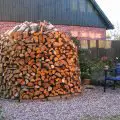If you don’t have the ability to consistently know how to identify wood logs then you may not be able to select your best option for your wood stove or campfire, as some have clear benefits over others.
The great news is, that with a few simple techniques, you will be able to identify many of the most common firewood species. This article will provide you with all the relevant information on how to tell trees apart for firewood, identifying types of firewood, and some of the most common firewood types.
Table of Contents
- Methods for Identifying Types of Firewood
- How to Tell Trees Apart for Firewood
- How to Identify Ash Firewood
- How to Identify Black Locust Firewood
- How to Identify Cherry Firewood
- How to Identify Elm Firewood
- How to Identify Hickory Firewood
- How to Identify Maple Firewood
- How to Identify Mulberry Firewood
- How to Identify Oak Firewood
- How to Identify Pine Firewood
- How to Identify Sycamore Firewood
- FAQs (Frequently Asked Questions)

Methods for Identifying Types of Firewood
So, you’re probably here because you’re wondering what kind of firewood do I have? Before getting into the 10 most common different types of firewood, let’s learn the methods on how to identify wood logs. These methods include checking the:
- End grain
- Bark
- Color
- Leaves
End Grain
The first method involves checking the characteristics of the end grain in order to identify firewood. This method is often used by foresters because it tends to be more accurate than any of the other methods that we’ll discuss.
However, in order to see the finer details of the grain, which in most cases is required, foresters often use a hand lens. Now, of course, the average person is not going to be carrying a hand lens with them all the time, so this method will probably only be helpful for certain types of wood that have very distinctive end-grain traits, such as Oak and Elm.
Elm has wavy rings on its end grain, which is a unique characteristic that no other type of wood has. This, therefore, makes it very easy to pick out from a pile of other wood without the need for a hand lens.
Bark
If you’re wondering how to identify firewood by bark, well, the bark is probably the people’s favorite tool for identifying firewood. Split firewood often still has bark attached to it, and this bark will have fairly distinctive bark patterns for different types of firewood. For instance, Shagbark hickory has very flaky bark that is extremely easy to pick out from other types of wood.
Overall bark is a great approach for identifying firewood, however, the downside of this method is that it is possible for the bark to fall off of split firewood. Plus, as the bark dries, or gradually decays, it will start to become more difficult to identify.
Color
The color is sometimes helpful and other times unhelpful for identifying firewood. Color can be a great approach for wood like Cherry, or Mulberry, as they both have a very unique coloration.
However, many different types of firewood are light brown in color, and the color of the wood will change as it dries and is exposed to sunshine. So, this approach can be good at points but is not always reliable as it can be hard to distinguish between the different types of firewood.
Leaves
Using leaves is a very classic approach for not only identifying wood, but also trees, and it’s the method most people will learn first. The only problem here with using leaves to identify firewood is that you may not always have leaves available when you’re at a firewood pile.
However, if you do have leaves available, they can certainly be a great tool for identifying the type of wood you’re looking at. Maple and oak, are some of the easiest types of wood to identify using leaves because of their easily recognizable shape.
How to Tell Trees Apart for Firewood
Now let’s get into identifying types of firewood. For each, we will discuss which of the four methods previously described will help you answer what kind of firewood do I have? We will discuss how to identify the following different types of firewood:
- Ash
- Black locust
- Cherry
- Elm
- Hickory
- Maple
- Mulberry
- Oak
- Pine
- Sycamore
How to Identify Ash Firewood
Ash firewood can be identified by its bark, color, and leaves.
Bark
If the bark is still on the Ash firewood, you can use this as an indicator. On Ash firewood, especially the larger trees, the bark forms in large parallel-like ridges. It looks kind of like tiny parallel mountain ranges.
In comparison, this is very different from Hickory, which grows bark in a thin plated pattern. Or Maple, which tends to have much tighter-fitting bark.
Color
To identify Ash firewood, you should be looking for a light white/brown color that is consistent throughout the wood. Most of the other types of firewood in this article will either have a darker color or will have fairly different colored heartwood (center of the wood) and the sapwood (outer ring of the wood).
Leaves
If the other two techniques don’t work for you, and there are leaves available, this can be a very accurate way of identifying Ash firewood. Ash trees have “opposite-compound” leaves, which means that where one leaf grows, there is always another one growing in parallel (directly opposite) to it.
And for a leaf to be compound means that each bud from the tree grows a series, or a chain, of leaves, instead of a singular leaf. In some areas in the USA, if you’re lucky, there are very few trees that have opposite-compound leaves which can make them easy to identify. As an additional distinguishing leaf characteristic, most types of Ash trees have around 7-11 leaflets.
How to Identify Black Locust Firewood
Black locust firewood can be identified by its bark, color, and leaves.
Bark
Although, not technically “bark”, but, Black Locust can be identified using the thorns. Black Locust is one of only a few species of trees that grows thorns directly from the tree. In Black Locust, these thorns will often grow near the point from which its leaves sprout.
So, if you’re looking at a branch and you can see thorns, then it’ll likely be Black Locust, as it’s more common than the other options.
Color
The easiest way to identify Black Locust firewood is from its bright yellow/brown color. However, this only works for freshly cut logs, because the color fades rapidly as the wood begins to dry.
Leaves
Finally, if you’re still unsure after attempting to use the above methods, whether they are possible or not, you can use the leaves to further identify whether it is the Black Locust you’re looking at.
Black Locust trees have alternate-compound leaves, which means that they grow down the branch in a left-right-left style pattern, along with each leaf being a chain of leaflets growing from a single bud off of its tree branch. On top of this, Black Locust leaves have a very high number of leaflets ranging from 9 to 19 per compound leaf.
How to Identify Cherry Firewood
Cherry firewood can be identified by its color.
Color
Cherry firewood has a light red color, in contrast to the majority of firewood having a light brown color. Cherry firewood is consistently red throughout the wood.
There, of course, are other types of firewood with some red color in the wood, like Mulberry. However, Mulberry isn’t consistent throughout and has a red-colored heartwood (the center of the wood) along with a white/brown-colored sapwood (the outer ring of the wood).
One issue is that the Cherry firewood’s red color may alter as the wood is exposed to varying elements. However, 9 times out of 10, you should be able to identify Cherry firewood by its color alone.
How to Identify Elm Firewood
Elm firewood can be identified by its end grain and leaves.
End Grain
Elm and Oak firewoods are probably the only types of wood that are recommended to identify using the end grain as your first method for identification.
The reason for this is because Elm has a characteristic that no other type of firewood has: the annual rings are wavy. For most types of wood, the lines of the annual rings are relatively uniform. But for Elm, the rings are wavy and almost look “blurry” so it’s easy to distinguish.
Leaves
Leaves are another option for identifying Elm firewood. Elm leaves are alternate-simple, meaning they grow in a left-right-left pattern along branches, and each leaf is singular (not part of a compound leaf). The edges of the leaves will look serrated, and the bottom of the leaves may feel fuzzy, kind of similar to a peach.
How to Identify Hickory Firewood
Hickory firewood can be identified by its bark and leaves.
Bark
The simplest way to identify Hickory firewood is using its very distinctive flaky bark. Not all types of Hickory have bark that hangs as freely as Shagbark does, for example, but most still have bark that grows in flaky sheets.
Leaves
You can also use the leaves to identify Hickory firewood. Hickory produces compound leaves that typically have 7-9 leaflets. In appearance, they may look a bit similar to Ash leaves, but you will see the difference by looking at a branch with leaves on it.
For Hickory trees, the compound leaf stems grow down branches in an alternating pattern compared to the compound leaf stems growing opposite to each other on the branches of Ash trees. If you find a tree that has compound leaves growing in an alternating pattern with 7-9 leaflets, it is more than likely going to be a Hickory tree.
How to Identify Maple Firewood
Maple firewood can be identified by its bark and leaves.
Bark
You may be able to notice right away how “tight” the bark is on Maple firewood. The best place to inspect the bark is from a branch, as this is where the feature is most prominent. But overall, Maple bark tends to be a lot more “skin-like” compared to bark from other types of firewood.
Leaves
Maple leaves are the most recognizable leaves in the world. They’re on the Canadian flag, bottles of Maple syrup, and many, many other places. And so, using the leaves is the easiest way to identify Maple firewood.
However, leaves may not always be available when it comes to identifying firewood.
How to Identify Mulberry Firewood
Mulberry firewood can be identified by its color and leaves.
Color
Mulberry is another species of firewood that is very easy to identify using its color. For Mulberry, you should look for a dark red heartwood (center of the wood) and whitish sapwood (outer ring of the wood). If you find a piece of firewood with this color pattern, then you will know it’s Mulberry.
Another very unique characteristic of Mulberry is the white streaks that it gets on the outside of the bark, more often than not under branches.
Leaves
If the bark doesn’t help you, you can also identify Mulberry wood using leaves when they’re available as they have alternate-simple leaves. This means they grow on branches in a left-right-left pattern, and grow as individual leaves. They are also small in size and have jagged edges.
If it’s the right time of year, you may also be able to spot their dark purple berries, which are very delicious.
How to Identify Oak Firewood
Oak firewood can be identified by its end grain and leaves.
End Grain
You can identify Oak firewood easily using the end grain of the wood. If you take a look at the end grain of your piece of Oak firewood, you should be able to see the normal annual rings that indicate how old the tree was.
In addition to these age rings, Oak has clearly visible lines that run perpendicular to the rings, going straight outward from the center of the wood. These lines are referred to as “rays”, and Oak is one of only two types of firewood that has rays that are visible without the need of a hand lens.
Leaves
If you happen to have a leaf on hand, you can identify Oak using the leaves. Oak leaves have a unique shape with 5-lobes, and they are alternate-simple leaves. If you manage to find a tree with leaves meeting these characteristics, then you’ve found an Oak tree. Also, another thing to look out for with Oak trees is that they produce acorns, so if you see any acorns, then you’re more than likely looking at an Oak tree.
How to Identify Pine Firewood
Pine firewood can be identified by its end grain and leaves.
End Grain
Pine firewood is one of the easiest types of firewood to identify with the end grain. You can use the end-grain, or even just the sides of the wood, to check for sticky sap. If you pick up a piece of wood that is sticky, then it’s almost definitely Pine. Pine also tends to have a lot of branches and knots on its side.
Leaves
Pine doesn’t have leaves, but instead, it has needles that are very distinctive. The majority of other firewood types have leaves, so this will enable you to discover the pine trees with ease.
How to Identify Sycamore Firewood
Mulberry firewood can be identified by its end grain, bark, and leaves.
End Grain
Sycamore and Oak are the only 2 types of firewood that have rays that can be seen with the naked eye. These rays are lines that run from the center of the wood to the outside. Rays on Sycamore are much smaller and closer together than those on Oak.
Bark
Sycamore has a very distinctive bark that is very easy to identify as firewood or when looking at a tree. Sycamore has flaky bark, and underneath this bark is an interesting whitish-green color. When you look at a piece of Sycamore the bark almost makes the wood look “naked”, with it being more prominent at the end of branches and the top of the tree.
Leaves
Sycamore trees can also be easily identified using their leaves. These leaves basically look like bigger Maple leaves, and so, the easiest way to pick them out from a group of other leaves is their large size and shape. Sycamore leaves are simple-alternate which means they grow on branches in an alternating pattern left-right-left, and each leaf grows singular.
FAQs (Frequently Asked Questions)
How do I know what kind of firewood I have?
You typically have four methods for distinguishing what kind of firewood you have. These include checking the end grain, bark, color, and leaves. Each type of firewood will be easily recognizable through one or two of these methods. Sometimes, it will be difficult to distinguish between different firewood with color as the majority take up a light brown color, except Cherry firewood which has a light red color, or Mulberry which has a dark red heartwood.
What does oak firewood look like?
You can identify Oak firewood easily by looking at the end grain of the wood. Here, you should be able to see the annual rings that indicate how old the tree was. In addition to these, Oak has clearly visible lines, referred to as rays, that run perpendicular to the rings, going straight outward from the center of the wood.





